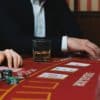

You can’t spell the word “gambler” without using poker.
This happens due to the simple reason that this particular card game happens to be the most popular and widely known of its kind worldwide. That being said there is a big part of the population which still doesn’t know how it is played.
This is why today’s article will be an introduction to poker for beginners.
After tackling all the Poker basics to get you started, we’ll let you in on some secrets regarding how you can manipulate the rules of the game and some simple math to have the extra edge on your opponents.
Poker Basic Rules
How is poker played? A simple but for many, a difficult question.
This game is easy to learn but tough to master. You may have heard the phrase “You have to practice 10,000 hours to master something”. The reason something like that sounds a bit far-fetched is that it is.
It may apply to some things but poker isn’t one of them.
Now make sure that you pay attention to what you read so that you can understand the basics good enough to get started. Everything you are about to read in this article applied to Texas Hold’em Poker which is the most popular and widely played poker variation in the world.
Before The Game
Even though only 2 people are needed to start the game, a poker table usually consists of 6+ players and the dealer. When played with friends, one of them can be the dealer but when played professionally there is a person whose job alone is to deal the cards and not be involved in the game himself.
Each round (many times referred to as a “hand”) starts with the dealer giving each player his cards in a clockwise fashion. Usually, this happens two times, and each player is dealt one hand per round for a total of his two cards.
Before the round can begin, there are two initial bets that are necessarily put down.
These are the blinds and are divided into the “small blind” and the “big blind”. The blind amounts are decided before the game starts. The big blind is double the small blind.
These blinds many times have the form of physical buttons, but usually, they will be imaginary.
Each round the players having to bet the initial blinds move clockwise (one seat per turn). That way the player with the big blind will then get the small blind and until the rest of the circle has finished he will not have to place the initial bet again.
The whole phase happens just so there is a small amount of money to start the round.
After that, the game can officially begin.
The Game Begins
After each player checks out his hand (his two cards) he has to perform one of the following actions:
- Call = place a bet equal to the big blind and thus join the round
- Fold = Give his cards to the dealer and exit the round
- Raise = place a bet higher than the small blind
- All in = bet all his available chips
For the two players with the blinds, those three actions still exist but they have more options.
The player with the small blind has to bet only the difference of the small with the big blind (which is equal to the small blind). The player with the big blind can “Check” which means to proceed to the next phase without betting any more money.
If a player on the table raises the pot then each of the players (moving clockwise) have to either call the bet, fold or raise again. When all the bets are settled then the second phase of the round kicks in.
The dealer proceeds to the flop (putting down the first 3 face-up cards). After doing so the betting stage starts again.
When all the bets are settled the dealer proceeds to the turn (showing the 4th card). Once again, after the betting stage ends, the dealer goes on to put down the 5th and final card called “the river”.
After that, the betting stage taking place will be the final one as well.
The game then proceeds to the final stage called the showdown where all the players reveal their hand, and the best one wins the round and thus the pot.
There is also a rule that applies to the dealer, but it is a good thing that you know it.
Before the dealer proceeds to the flop, the turn, and the river, each time he will have to “burn” a card which means to take the top card of the deck and place it on its bottom.
Winning
And now that you know how the game is played you must be wondering how the winner is decided.
There are specific possible combinations between a player’s hand and the dealt by the dealer face-up cards that based on the strength determine the winner.
Here Are The Possible Combinations Ranked From Weakest To Strongest:
- High Card = when no one has at least a single pair then the person/s with the strongest card wins. Cards in order of descending power are A, K, Q, J, 10, 9, 8, 7, 6, 5, 4, 3, 2, and 1.
- One pair = have a combination of two same numbers like two 5s, two 7s and so on.
- Two pairs = have two same combinations like both two 6s and 3s.
- Three of a kind = have a combination of three same numbers like three 10s.
- Straight = have five numbers in a row like 3-4-5-6-7 or anything of that sort.
- Flush = have five numbers of the same figure, NOT colour, like an A-4-5-8-9 all of which are clubs, hearts, spades, or diamonds.
- Full house = have three of a kind and another pair like 4-4-4-5-5.
- Four of a kind = have a combination of four same numbers like four Qs.
- Straight Flush = When you have a straight which is a flush at the same time like 5-6-7-8-9 all of them being of the same figure.
- Royal Flush = the most powerful possible hand you can have in Texas Hold’em which is a straight flush of 10-J-Q-K-A. In some Poker variations, the figure of a Royal Flush can beat another.
And this is where the round ends. As for the introduction to poker for beginners, this is what you must know to be able of playing the game.
Poker Tactics
If you were to ask us whether poker tactics do or don’t exist, we would go with the former option as our answer.
Yes, indeed they do exist and are based on math. They are divided into two categories, the first doesn’t include any math but the second (best one) does.
We will start with the first one since it is way easier and doesn’t require you to go through multiple mathematic equations in your mind on each phase of a poker round.
1.) No Math (Easy Tactic)
Things here are simple. You will join the game only if you have the big blind or when your hand is something relatively powerful. That would be a pair of 9s or better.
It could also be a strong combination like 10-J, Q-K, Q-A etc. The best hand on Poker is the pair of As.
Then depending on how strong your hand is in each of the dealing phases it will be up to you to decide whether it is sensible to keep on going or fold. The chance of winning is way higher when playing like that.
2.)Math Is Mandatory (Hard Tactic)
This one is all about calculating the possible outcome of the next dealt hand or your win based entirely on percentages.
This can be done in two ways. Ignoring your opponents’ possible hand and guessing what it may be. The logic of determining your odds remains the same either way.
Let’s say for example that you have a 4♦ and a J♦ and the flop has shown an A♦, a 4♣, and a 7♦. That would mean that if another diamond is dealt, then you would have completed a Flush. How would you calculate the odds of getting a diamond on the turn? Things aren’t as tragic as you may think.
First, you think how many cards of each suit (♦♣♠♥) there are in each deck. There are 13. Then you calculate how many you know are already in play. Since you are ignoring the possible opponents’ hands in our example there would be 4 diamonds in play and that would leave you with 9 more to go.
So, let’s say you have 3 opponents. Each of them holds two cards which means 6 cards in total. 3 cards are down (flop) and you hold another 2 cards. The whole deck has 52 cards.
52 (Deck) – 3 (Flop) – 8 (four players’ hands) = 41
We are ignoring your opponents’ hand so let’s say you still have 9 possible “outs” (the card’s figure you want to be dealt). So the cards to outs ratio here would be 41:9.
That means that out of the 41 remaining cards in the deck, 32 of them will not do you any good. So your odds of getting a flush would be 32:9 which is roughly 3:1 so your chances would be close to 25%.
If you still don’t get a diamond in turn then the chance of getting it in the river are halved (12.5%).
Conclusion
This is our introduction to poker for beginners. Now that you know all the poker basics to get you started you should be prepared enough to hit the tables.
Just a reminder though, before betting with real money play a bit with your friends or practice on a free online poker game (Zynga Texas Hold’em Poker on Facebook/mobile app is an excellent choice).
And if you need more information, read more on How To Play Poker Online.










This site was… how do I say it? Relevant!! Finally I have found something which helped me. Thank you!